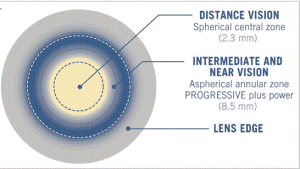Short-sightedness or myopia causes blurred distance vision (eg. the board or screen at school).
It often starts around 10 years of age and gradually worsens through teenage years. Until fairly recently it was thought that genetic inheritance was the main cause.
Then research began finding a link with prolonged close work (computer and phone screens and book reading).
The latest research an additional important factor: time spent outdoors.* Children who spend little time outdoors are more likely to become more short-sighted than children who enjoy outdoor activities.
So what can be done?
- Encourage your child to spend as much time as possible in outdoor activities.
- Have your child fitted with bifocal contact lenses – Bifocal contact lenses, worn every day, have been shown to significantly reduce the increase in myopia. Many studies have no shown this with an average reduction of up to 50% yearly.**
- Bifocal glasses may also reduce myopia, but the effect is not as great as with contact lenses.

- Bifocal lens for myopia
Bifocal contact lenses work quite differently to glasses.
The near vision portion of the lens is not just at the bottom of the lens, but all the way round, which makes the difference.
Ewan is now fitting these contact lenses for children with myopia. Call 03 9583 0855 to make an appointment for a consultation.
*French, A.N., et al., Time outdoors and the prevention of myopia, Experimental Eye Research (2013): “There is strong evidence from both cross-sectional and longitudinal data that children who spend more time outdoors are less likely to be or become myopic. This finding is supported by evidence from studies in a number of different locations and ethnic groups, including those with high prevalences of myopia”
** Pascal. (2017, June 13). Misight presented at BCLA 2017 | myopia care. see https://www.myopiacare.com/misight-presented-bcla-2017/
